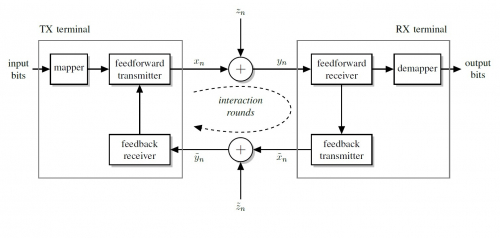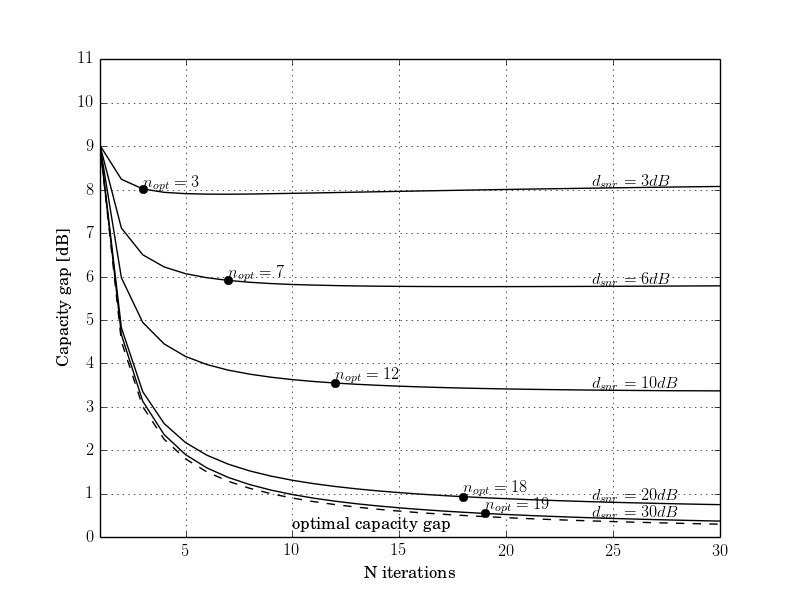- RAMOT at Tel Aviv University Ltd.
- From Israel
- Responsive
- Innovative Products and Technologies
Summary of the technology
A low-complexity low-latency interactive communication system with spectral efficiency approaching the Shannon limit
Project ID : 4-2014-792
Details of the Technology Offer
Background
Digital communication systems use forward error correction (FEC) in order to be spectrally efficient and approach the Shannon limit. The drawbacks of using FEC are high latency and high computational complexity. On the other extreme, communication systems without FEC (uncoded systems) have minimal latency but are bounded away from capacity by typically 9dB (at a practical BER), meaning that they require over eight times the transmission power relative to an optimal communication system, in order to convey the same bit rate with the same reliability. It is known in the art that if perfect feedback is present, i.e. if the transmitter can noiselessly and instantaneously observe the signal at the receiver’s input, then the Shannon limit can be approached via simple communication protocols. Unfortunately, these simple protocols completely fail in the presence of arbitrarily low noise in the feedback, and hence are grossly impractical.

Novelty
This invention is the first construction of a simple interactive communication protocol that is robust to feedback noise, rendering it both practical and near-optimal. Specifically, our protocol approaches the Shannon limit of spectral efficiency, while maintaining a very low latency and offering several orders-of-magnitude savings in computational complexity, relative to state-of-the-art counterparts. For example, we show that if feedback power is 10-20dB higher than feedforward power, then the spectral efficiency can get as close as 1-3dB to the Shannon limit, with a latency of less than 20 channel uses. Juxtaposed against current solutions, this implies an improvement of 6-8dB under the same latency constraints, or over two orders of magnitude reduction in latency and computation power under the same spectral efficiency target.
Novel Features and Advantages:
1. Low complexity: No FEC is required and the computation load per bit is over two orders-of-magnitude lower compared with state-of-the-art competing technologies
2. Low latency: Our solution significantly reduces the end-to-end delay of the information bits, by over two orders-of-magnitude
3. Resource savings: Our design is simpler, requires significantly less memory and processing power, and has lower power consumption. This translates to a smaller silicon die size and hence to significant cost savings and significantly longer battery life
4. Link budget/range enhancement: Thanks to its lower power consumption, our system can significantly improve the overall link budget. This can be translated into a corresponding enhancement in range and coverage
5. Graceful link adaptation: Our system is easily tweaked to respond to variations in link quality, by means of adjusting two scaling parameters, while retaining the same level of optimality with respect to the new link conditions. In contrast, existing solutions use a number of different FEC modules tailored to different channel conditions, which incur either a large complexity or performance penalty
6. Optimality under low-latency constraints: State-of-the-art FEC systems typically incur a delay of several thousands of bits, in order to operate close to the Shannon limit. Thus, under low-latency constraints (e.g. less than 100 bits), FEC cannot be used and therefore uncoded systems are employed. This type of solutions incur a typical penalty of over 9dB. Under the same conditions, our system can reduce the penalty to 1-3dB, hence savings 8-6dB in power
7. Physical-layer security: Our technology enjoys an inherent physical-layer encryption-like mechanism. An eavesdropper who listens to the transmission of both the forward and the feedback link with even the smallest amount of noise can learn virtually nothing on the information bits. Unlike traditional encryption algorithms, this requires no further processing and is stochastically secure at the physical layer. i.e., cannot be broken by any amount of computational power
Potential Applications
The invention is suitable for any application where terminal A would like to convey information to terminal B, and the former is more power limited than the latter, or alternatively, sees a worse channel. In such situations, the described interactive communication system will enjoy either a significant savings in power relative to state-of-the-art schemes that work within the same delay, rate, and error probability constraints and comparable complexity; alternatively, our scheme enjoys a significant reduction in encoding and decoding complexity (hence in processing power and silicon die size) as well as in encoding delay, relative to state-of-the-art FEC codes with the same rate and error probability. Some possible applications include:
1. Wireless Capsule Endoscopy (WCE): WCE is a method of capturing images inside the digestive tract, via a battery operated swallowable pill comprising a video camera and a transmitter. This imaging method is extremely appealing, being non-intrusive, as well as reaching areas of the tract that are not accessible by traditional endoscopies. The major bottleneck hindering the transference of this promising technology to mass markets is battery power, which currently limits the video frame-rate to below par. Our invention will allow a significant reduction in power consumed by radio transmission, enabling an improvement in video quality and rendering this technology more applicable
2. Wireless Sensor Networks (IoT): Wireless sensor networks of spatially distributed battery-operated sensors and actuators, used for monitoring and controlling physical or environmental conditions, such as temperature, sound, etc., and pass their data to a central location. Such networks are used in many industrial and consumer applications, such as healthcare monitoring, air pollution monitoring, water quality monitoring, data logging, etc.
3. Other low-power communication products, including home automation, wearable technologies, etc.
Technological and Commercial Background
Low-power wireless applications are becoming increasingly ubiquitous. With the precipitous growth of bit-rate, bandwidth and real-time demands in such applications, the power consumption and cost become a major bottleneck, and better and more efficient techniques are constantly sought.
Prominent examples for such markets include:
1. Wireless Sensor Networks (WSN, IEEE 802.15.4) with applications such as healthcare monitoring, air pollution monitoring, water quality monitoring, data logging, etc.
2. Medical applications such as Wireless Capsule Endoscopy (WCE) and Medical Implant Communication Service (MICS)
3. Wireless technologies for home automation
4. Wearable technologies
Patents
Patent pending


